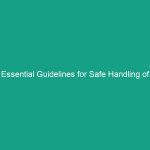Good Morning Team!
Today, we are going to discuss an essential topic that affects each and every one of us in our daily operations: Essential Workplace Building Materials Safety Guidelines You Must Know. Understanding and applying these guidelines not only ensures our Safety but also enhances our productivity and efficiency on the job. Let’s dive into why these guidelines are crucial for our workplace and how adhering to them can prevent accidents and injuries.
Understanding Essential Workplace Building Materials Safety Guidelines
The term Building Materials Safety Guidelines refers to the protocols and Procedures in place to manage the safe handling, storage, and usage of materials that we work with on construction sites and in buildings. These guidelines are vital because they help mitigate risks associated with hazardous materials, ensuring that our work Environment remains safe for everyone.
Many employees may think that safety guidelines are just bureaucratic red tape, but the reality is that they are designed to protect us. Ignoring these guidelines can lead to severe injuries, property damage, and even fatalities. Understanding the importance of these safety practices is the first step in creating a safer workplace.
Key Hazards, Risks, and Safety Considerations
When it comes to building materials, there are several Hazards we need to be aware of:
- Chemical Hazards: Many building materials contain chemicals that can be harmful if inhaled, ingested, or come into contact with the skin.
- Physical Hazards: Heavy materials can cause injuries if dropped or improperly handled. Lifting techniques and proper equipment are essential.
- Environmental Hazards: Working with materials that produce dust or require specific environmental controls can pose respiratory risks.
- Improper Storage: Inadequate storage of materials can lead to accidents, such as slips, trips, and falls.
Ignoring these hazards can lead to serious consequences, including long-term health issues, legal repercussions, and impact on team morale. It’s essential to recognize these risks and take proactive measures to address them.
Best Practices, Procedures, & Actionable Advice
Step-by-Step Safety Procedures
Here are some Best Practices every employee should follow to ensure safety while working with building materials:
- Read Labels and Safety Data Sheets (SDS): Always familiarize yourself with the materials you are handling. Understand the hazards and recommended Safety Measures.
- Use Personal Protective Equipment (PPE): Always wear appropriate PPE such as gloves, goggles, and respirators when necessary. This is your first line of defense against injury.
- Follow Proper Lifting Techniques: Use your legs, not your back, to lift heavy materials. If the item is too heavy, ask for help or use equipment like forklifts or hoists.
- Store Materials Correctly: Ensure all materials are stored in designated areas and stacked securely to prevent falls or collapses.
- Maintain Cleanliness: Keep work areas tidy to prevent slips, trips, and falls. Ensure that spills are cleaned immediately and that pathways are clear.
Real-Life Examples
To illustrate the importance of these practices, consider the following incidents:
- In 2021, a construction worker sustained severe injuries after a stack of improperly stored bricks fell. This could have been prevented with proper stacking and storage protocols.
- A worker exposed to hazardous chemicals without appropriate PPE developed respiratory issues that could have been avoided through proper safety practices.
These examples serve as a reminder that we must take safety seriously. Each of us plays a crucial role in maintaining a safe working environment.
Regulations, Standards, and Compliance
Understanding Workplace Safety regulations is critical. The Occupational Safety and Health Administration (OSHA) provides guidelines that employers must follow to ensure Workplace Safety. Compliance with these Regulations protects not just the employees but also the company from potential legal issues.
Some key regulations include:
- osha Construction Standards: These outline requirements for working with construction materials safely.
- Hazard Communication Standard: This mandates employers to inform employees about hazardous materials they may encounter.
- Personal Protective Equipment Standards: These standards dictate the appropriate PPE that must be provided to employees.
Adhering to these regulations is not just a legal obligation; it’s a commitment to each other’s safety and well-being.
Employee Engagement & Discussion
Now that we have covered the essential building materials safety guidelines, I want to hear from you. Here are some questions to consider:
- What safety challenges have you encountered related to building materials?
- Are there any specific materials you feel require more attention regarding safety protocols?
- How can we improve our safety practices as a team?
Your experiences and insights are invaluable in fostering a culture of safety. Let’s open the floor for discussion and share our thoughts on enhancing safety in our workplace.
Conclusion & Key Takeaways
In conclusion, understanding and implementing Essential Workplace Building Materials Safety Guidelines is crucial for ensuring a safe work environment. Remember the key points we discussed:
- Always be aware of the hazards associated with the materials you handle.
- Use the proper safety equipment and follow Best Practices.
- Stay informed about regulations and compliance standards.
By prioritizing safety, we protect ourselves, our coworkers, and our workplace. Thank you all for your attention today and for your commitment to making our workplace a safe environment. Let’s continue to look out for one another and keep safety at the forefront of our daily operations!


